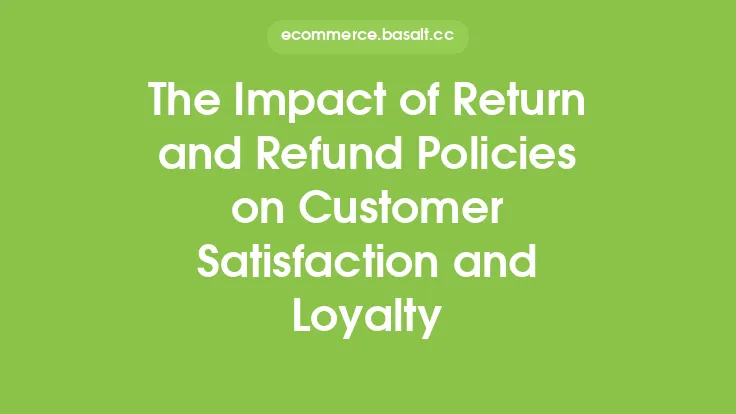When it comes to building a successful e-commerce business, one of the most critical aspects to consider is the return policy. A well-crafted return policy can make all the difference in establishing trust with customers, reducing returns and exchanges, and ultimately driving sales. In this article, we will delve into the world of return policies and explore the key elements that make a customer-friendly return policy.
Understanding the Importance of a Return Policy
A return policy is a set of rules and guidelines that outline the process for returning or exchanging a product. It is essential to have a clear and concise return policy in place to protect both the customer and the business. A good return policy should be easy to understand, fair, and flexible. It should also be readily available to customers, either on the website or through customer support. By having a well-defined return policy, businesses can reduce the risk of disputes and misunderstandings, which can lead to negative reviews and a loss of customer trust.
Key Elements of a Customer-Friendly Return Policy
So, what makes a return policy customer-friendly? There are several key elements to consider when crafting a return policy. First and foremost, the policy should be easy to find and understand. It should be clearly outlined on the website, and customers should be able to access it quickly and easily. The policy should also be fair and reasonable, taking into account the customer's needs and expectations. Additionally, the policy should be flexible, allowing for exceptions and special circumstances. Some other key elements to consider include:
- A clear and concise explanation of the return process
- A reasonable timeframe for returns and exchanges
- A straightforward process for initiating a return or exchange
- A clear explanation of any restocking fees or other charges
- A guarantee of a full or partial refund, depending on the circumstances
Crafting a Return Policy that Meets Customer Needs
To craft a return policy that meets customer needs, businesses should consider the following factors. First, they should think about the types of products they sell and the potential reasons why customers may want to return them. For example, if a business sells clothing, they may want to consider a return policy that allows for exchanges or returns due to sizing issues. They should also consider the customer's expectations and needs, such as a quick and easy return process. Additionally, businesses should think about their competitors and the return policies they offer. By researching the competition, businesses can gain a better understanding of what customers expect and can craft a return policy that meets or exceeds those expectations.
Communicating the Return Policy to Customers
Once a business has crafted a customer-friendly return policy, they need to communicate it effectively to their customers. This can be done in several ways, including:
- Clearly outlining the return policy on the website
- Providing a link to the return policy on the website or in customer communications
- Including the return policy in customer support materials, such as FAQs or knowledge bases
- Training customer support staff to clearly explain the return policy to customers
- Including the return policy in packaging or shipping materials
Monitoring and Adjusting the Return Policy
Finally, businesses should regularly monitor and adjust their return policy as needed. This can be done by tracking customer feedback and complaints, as well as monitoring return and exchange rates. By regularly reviewing and updating the return policy, businesses can ensure that it remains customer-friendly and effective in reducing returns and exchanges. Additionally, businesses should be open to making changes to the return policy based on customer feedback and suggestions. By being flexible and responsive to customer needs, businesses can build trust and loyalty with their customers, which can ultimately drive sales and revenue.
Best Practices for Implementing a Return Policy
To ensure that a return policy is effective and customer-friendly, businesses should follow several best practices. First, they should make sure the return policy is easy to find and understand. This can be done by clearly outlining the policy on the website and providing a link to it in customer communications. Businesses should also ensure that the return policy is fair and reasonable, taking into account the customer's needs and expectations. Additionally, businesses should regularly review and update the return policy to ensure it remains effective and customer-friendly. Some other best practices to consider include:
- Providing a clear and concise explanation of the return process
- Offering a reasonable timeframe for returns and exchanges
- Making it easy for customers to initiate a return or exchange
- Clearly explaining any restocking fees or other charges
- Guaranteeing a full or partial refund, depending on the circumstances
The Benefits of a Customer-Friendly Return Policy
A customer-friendly return policy can have numerous benefits for businesses, including increased customer trust and loyalty, reduced returns and exchanges, and increased sales. By having a clear and concise return policy in place, businesses can reduce the risk of disputes and misunderstandings, which can lead to negative reviews and a loss of customer trust. A customer-friendly return policy can also help to increase customer satisfaction, which can lead to positive reviews and word-of-mouth marketing. Additionally, a well-crafted return policy can help to reduce the costs associated with returns and exchanges, such as shipping and handling costs. By crafting a customer-friendly return policy, businesses can build trust and loyalty with their customers, which can ultimately drive sales and revenue.





